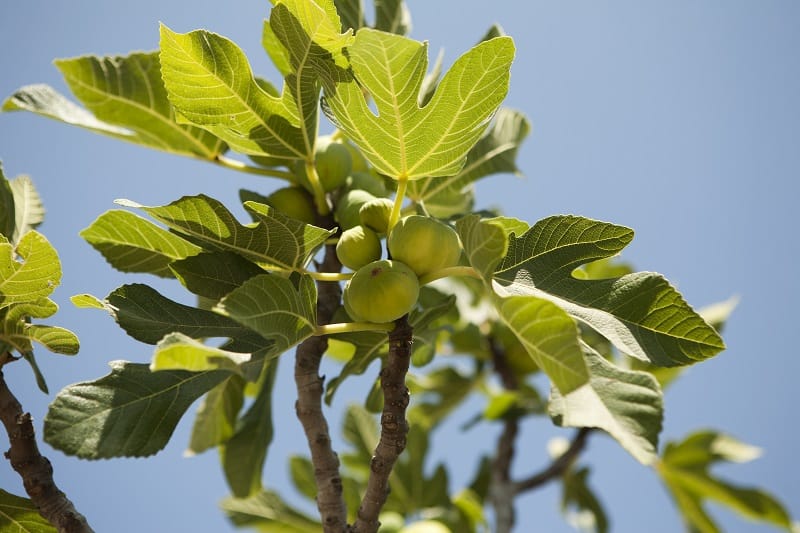
The fig plant belongs to the mulberry family, Moraceae, and is native to Asia and the Mediterranean, although it grows in most countries with warm climates. The fruit is rich in calcium, potassium, phosphorus and iron. Unfortunately, fig plants also have their share of ailments and afflictions, some of which cause their leaves to turn yellow.
Reasons for Fig Leaves Turning Yellow
1. Insufficient or too much water
Fig trees originated from the Mediterranean, and their roots tend to grow close to the surface to absorb every drop of water and moisture. The water that is not absorbed drains through the porous soil. To prevent the leaves from turning yellow, water your plants at least once a week.
The soil should preferably be fast-draining; you should avoid incorporating moisture-retaining additives in the soil when transplanting your plants. Mulch well around the base of the fig tree to retain more water on the surface.
2. Transplant shock
One of the reasons fig leaves turn yellow could be due to transplant shock. Transplanted fig plants can suffer from stress and up to 20 percent of their foliage could be lost. Fluctuating temperatures during transplanting could also cause yellowing leaves. Make sure that proper planting requirements are met so you can avoid transplant shock for your fig trees.
3. Nutrient deficiency
Fig leaves turning yellow could indicate a deficiency in nutrients such as nitrogen, which is essential for healthy cell growth and division. Without nitrogen, the cell structures or chloroplasts cannot supply energy and nutrients to the fig plants. Fertilizing your plants annually can solve the issue, although the yellowed leaves are unlikely to turn green again. The yellow leaves should fall off so they can be replaced with healthy green ones.
4. Pest infestation
Insects and pests can invade even fig trees, and this can cause yellow leaves. Spider mites, scale and mealybugs can cause damage to foliage leading to more serious scenarios. Eradicate them with insecticides or insecticidal soap. If the situation is handled promptly, it will not lead to fatal damage and your fig plants will be able to recover easily.
5. Bacterial infection
Fig leaves turning yellow may also be due to a bacterial infection. In this case, pathogens usually target young leaves. To treat the problem, re-pot your plants with fresh earth and be sure to remove any remaining yellow leaves.
Other Problems with Fig Leaves
Excessive leaf loss
Fig trees may lose leaves excessively. To avoid this, allow your plant to acclimatize if you have just bought it recently. During such times, plants tend to lose leaves around the bottom part. When you notice that the top three to four inches of soil are dry, water the plant immediately.
These plants prefer indirect sunlight; also make sure they are not placed near an air conditioning system to avoid excessive leaf loss.
Brown spots
The appearance of brown spots is an indication of overwatering, and many beginner gardeners have this experience. Excess moisture leads to root decay and root rot, and the fungal infection spreads upward, leaving brown spots on the leaves. To treat this, you need to re-pot your fig tree and remove the affected leaves. See to it that there is enough light for the plant to recover.
Leaves with holes
Check your fig tree thoroughly, as this may be an indication of pest infestation. You can treat the problem by applying neem oil directly to the leaves. You can also remove the bugs manually or spray them with isopropyl rubbing alcohol. A spray consisting of liquid dish soap and water is also ideal for removing bugs.
Curled leaves
Sometimes, fig tree foliage may curl up on the sides along with developing brown spots. These leaves tend to have a darker shade. The curling and browning usually start along the edges, until they reach the inner part of the leaves. This usually means your tree is thirsty, so always water the plants thoroughly while also making sure you are not overwatering.
White leaves
Fig leaves may also develop white areas, and this is mostly attributed to mildew or sunburn. Stems and leaves are prone to developing a white powder-like substance, called mildew. This fungal disease appears due to lack of airflow along with stagnant water, low light conditions, and a temperature of around 70 degrees Fahrenheit.
To treat the problem, trim the fig tree for better airflow and choose a humidifier over misting. Be sure to remove all the white leaves and apply neem oil over the healthy ones to contain the infection. You can also spray the fig tree thoroughly with a mixture of baking soda and water.
If the leaves are turning white but there is no trace of a powdery substance, it could be sunburn rather than mildew. If the plants are exposed to too much sunlight, the leaves tend to become bleached. The top leaves are the most affected, while the lower ones remain healthy since they benefit from the shade. To prevent this, move your fig trees to a shady area or further away from windows.
Conclusion
Fig leaves turning yellow can be distressing for plant owners, but the correct assessment of the problem could save your plants. The common reasons for yellowing leaves are overwatering or transplant shock. However, it could also be due to nutrient deficiency, pest infestation or a bacterial infection.
Image: istockphoto.com / RiccardoTravani